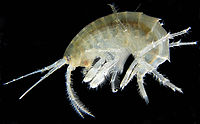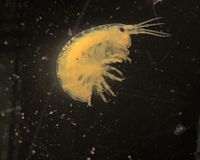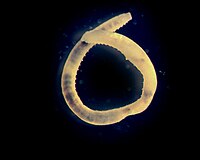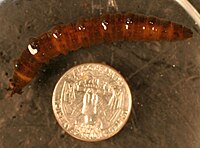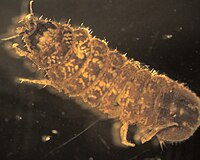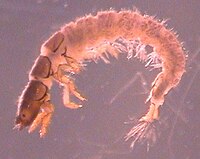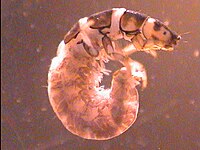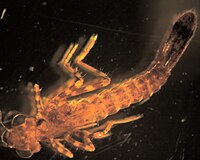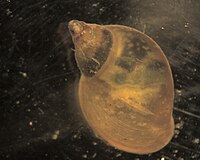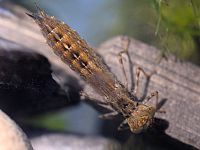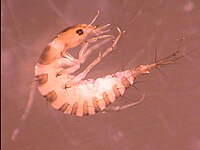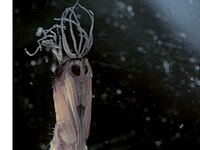Fox Meadow Brook
From WikiEducator
| Stream code: | BRX_FxMdBrk_155 |
| Basin: | Bronx River |
| State or Province: | New York |
| Country: | USA |
| Latitude: | 41.001867 |
| Longitude: | -73.801533 |
| School: | DeWitt Clinton High School |
The following are the most common invertebrates collected from this stream site.
Contents
Gammaridae
The body of this scud is flattened side-to-side. It has seven pairs of walking legs and two pairs of antennae. On third third antennal segment, there is a segmented flagellum.
Images of the body flattened side-to-side, and the segmented flagellum.
Hyalellidae
The body of this scud is flattened side-to-side. It has seven pairs of walking legs and two pairs of antennae. The first pair of antennae is shorter than the second pair in members of this family.
Oligochaeta
Aquatic earthworms lack legs and are characterized by having 20 or more segments. Unlike leeches, they lack a suction disk. We collect members of two or more orders in this class as small numbers of stream sites and they are rarely numerous. They are more common at pond and lake sites.
Image of the 20 or more segments.
Tipula
This genus of Tipula is rather large as compared with other genera. Tipula larvae are generally dark brown and have creeping welts.
Asellidae
These aquatic sow-bugs have seven pairs of legs and a dorso-ventrally flattened body. They have two pairs of antennae; one pair is much longer than the other pair.
Images of the body and the two pairs of antennae.
Cheumatopsyche
Cheumatopsyche has a forked foretrochantin (as does Ceratopsyche). The foretrochantin is the projection at the uppermost portion of the front leg closest to the head. The leg may need to be pulled away from the body to expose this feature. Cheumatopsyche have a small or inconspicuous pair of sclerites under the prosternal plate that are difficult to see. Contrast that with the larger pair of sclerites found on Ceratopsyche. To access sclerites, it's best to gently pull the pronotum and mesonotum in opposite directions. Note: the large single sclerite is the prosternal plate. Cheumatopsyche have only 2 types of hair on the abdomen: long thin plain hairs and thicker club hairs, which are narrow close to the body and widen out at the distal end. Paired sclerites on the ninth abdominal segment are notched.
Ceratopsyche
Ceratopsyche has a forked foretrochantin. The foretrochantin is the projection at the uppermost portion of the foreleg. The leg may need to be pulled away from the body to expose this feature. Ceratopsyche have a large pair of sclerites underneath the prosternum. Note: the large single sclerite is the prosternal plate. Biologists have gone back and forth between lumping this genus into Hydropsyche and splitting it back out. ITIS currently lists it as a genus (Feb 2013) but we are aware of a recent paper that lumped it under Hydropsyche.
Coenagrionidae
- Order
- Odonata
- Family
- Coenagrionidae
- Common name
- narrowwinged damselflies
- Tied fly
- Polly's Green Damsel
These damselfly larvae (sub-order Zygoptera) can be distinguished from dragonfly larvae (sub-order Anisoptera) by their more slender bodies and the presence of three leaf-like gills at the end of the abdomen and The family Coenagrionidae is characterized by its distinctly shaped labium which may or may not be extended.
Images of the gills at the end of abdomen, and another here. An image of the labium, and an extended labium.
Lymnaeidae
Members of the family Lymnaeidae belong in the class of Gastropoda. Members contain a single, coiled shell with a right-handed spiral. Differing from those of Planorbidae, members of Lymnaeidae have a larger opening. Respiration in these snails are through lung-like structures. Preferred habitats include those with slow streaming waters and heavy vegetation. These right handed snails are somewhat less tolerant of water pollution than our other common snails.
Images of the family Lymnaeidae and the class Gastropoda.
Aeshnidae
All dragonflies have five points sticking out from the back end. Members of this family of dragonflies are distinctly long as can be seen in the photograph. Other common families tend to be a wider and flatter. If you pull out on the mouthparts under the head you'll see that they look flat in side view. If they look spoon-shaped then it is from a different family. Like other Odonata, members of this family have four wingpads. Like members of the sub-order Anisoptera, the abdomen terminates in five points. The prementum and palpal lobes of this dragonfly are flat when viewed from side.
Images of the four wingpads, the abdomen, the prementum and palpal lobes, and a view from the the side.
Dytiscus
Adult Dytiscidae have streamlined bodies and hind-legs modified for swimming. They are characterized by the division of the first abdominal segment by the hind coxae. Don't let the paired claws and prominent 'tails' of Dytiscus larva tempt you to think 'stonefly'; these tails are far less segmented than Plecoptera tails.The head and jaws are also unlike those of stoneflies.
Images of the hind-legs, first abdominal segment, 'tails', Plecoptera tails, and the head and jaws.
Diptera
Pupae from the order Diptera are typically found in small numbers at every site. These can be identified further, but we do not.
Chironomidae
Midge larvae tend to be the most common macroinvertebrate at our sites. As with other Diptera, there are no true jointed legs. Chironomidae do have a pair of prolegs at each end and preserved individuals tend to curl into a 'C'. Identification past family requires slide-mounted heads. We have seen philopotamid caddisflies misidentified with the chironomids and we suspect that that happens when samples are being sorted from trays. Under a microscope, six prominent legs can be seen on members of the caddisfly family Philopotamidae.
More information on Philopotamidae.

